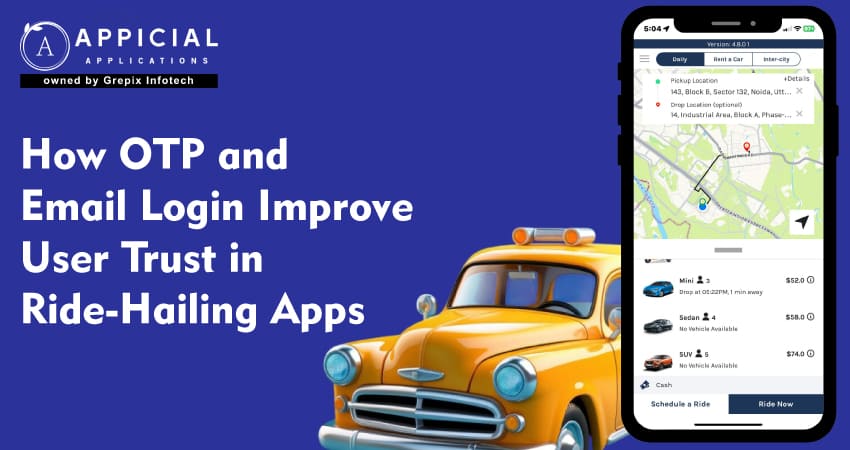
How OTP and Email Login Improve User Trust in Ride-Hailing Apps
User trust is a cornerstone of any Uber Clone or ride sharing app. Without trust, users will abandon the app. In a ride hailing app or e-hailing app, users must feel safe.
They must believe their identity is protected. They must feel secure about payment, communication, and matching. Using OTP login and email login mechanisms plays a direct role in building that trust.
These login methods serve three key functions: verification, identity assurance, and friction minimization. They guard against fake accounts, spam, or misuse. They reassure users that the app, whether a white label taxi booking app or custom-built, cares about security.
A good taxi app development company or white label taxi app development company will prioritize these methods.
In the sections ahead, we will break down how they work, why they help, comparative strengths, challenges, best practices, and answers to commonly asked questions.
In this blog, we explore how OTP login (One Time Password) and email login systems strengthen user trust in ride-hailing app environments. We discuss technical benefits, user psychology, security trade-offs, implementation best practices, and comparative risks. We tie in these features to Uber Clone style ride sharing app solutions, e-hailing app models, and white label taxi booking app offerings. We examine how a competent taxi app development company or white label taxi app development company should approach them. At the end, we present five FAQs to address common concerns. In the conclusion, we highlight how Appicial Applications can help build such secure and trusted login systems.
What is the Role of Authentication in Ride-Hailing App Ecosystem?
Authentication is the gatekeeper. Without it, anyone might register and misuse the system. In a ride sharing app, bogus users or drivers degrade service quality and safety. A ride hailing app without verified login risks fraud, ghost rides, and mistrust.
In an e-hailing app, where users share sensitive data (phone, location, payment), when login is weak, trust breaks. On the other hand, strong login builds confidence. OTP and email login provide layers: verifying that the user controls a phone or email. They help prove identity early.
For a white label taxi booking app, login methods are often baked in. But choosing the right white label taxi app development company or a proper taxi app development company ensures these login flows are robust, clean, and seamless.
OTP Login: Mechanism and Advantages
OTP login means sending a one-time password (via SMS or email) to the user, which they enter to authenticate themselves. This method is commonly used to prevent password fatigue, reduce barriers, and improve security.
How OTP Login Works?
A user enters their phone number. The system generates a random numeric code (e.g., 6 digits). It sends this to the user via SMS or sometimes via email. The user enters the code. If it matches, the user is logged in (or registered). The code expires after a short time (e.g., 5 minutes).
Advantages of OTP Login in Ride Apps
- Simplicity & Convenience: Users do not need to remember passwords. They only respond to a code.
- Device link: Because the OTP goes to the user’s phone, it ties the account to a physical device. This aids accountability.
- Reduced friction: Many users prefer OTP to password setups. It is faster, especially for first-time onboarding.
- Mitigates weak passwords: Users often choose simple or reused passwords. OTP avoids that risk.
- Better conversion: Studies show that login flows with OTP avoid drop-offs more than password registration flows.
- Deters bots/fake signups: OTP introduces a human step (manual input), which blocks automated attacks.
For a ride-hailing app, where user trust and safety are critical, OTP login is often a default choice. Even in an Uber Clone setup, OTP gives legitimacy. A white label taxi booking app should support OTP flows. A taxi app development company should configure OTP thresholds (how many attempts, lockouts) and fallback options.
Email Login: Mechanism and Its Value
Email login is a more traditional method. The user enters email + password, or uses email-based “magic link” to log in. It complements OTP login, especially for users without reliable SMS access.
How Email Login Works?
The user signs up with an email address. They set a password or request a magic link. If password login, they enter email + password. If magic link, they click the link sent to their email, which logs them in.
Advantages of Email Login for Ride Apps
- Alternative for non-SMS users: Some users may not have reliable phone service or prefer email.
- Persistent credential: Email + password gives a stable login path.
- Recovery path: If the user loses access to the phone, the email provides a backup.
- Integration with marketing & account features: Email allows newsletters, receipts, and notifications.
- Professional feel: Many users expect email login as a baseline.
Together with OTP login, email login makes the login system more resilient. In a ride-sharing app or ride-hailing app, offering both options gives flexibility. The e-hailing app must allow email login fallback. A white label taxi booking app should come with both options. A taxi app development company should build flows that gracefully combine OTP and email login.
Why OTP & Email Login Build Stronger Trust?
Trust is psychological as much as technical. Users want to feel secure, protected, and respected. The combination of OTP and email login helps in multiple ways.
Verification Creates Accountability
When a user is verified via OTP, it asserts that they control a phone. When paired with email login, it adds another identity channel. This dual verification makes it harder for malicious actors to slip in.
Improves Transparency
Showing that a code was sent (with a timestamp) and limiting login attempts signals to users that the system enforces rules. It fosters confidence.
Reduces Fraud & Malicious Behavior
Fake accounts result in ghost bookings, scams, or exploitation of driver incentives. Strong login methods reduce that. This is vital for a ride hailing app or e-hailing app. A poorly secured Uber Clone invites fraud.
Enhances Security Without Friction
OTP + email login, when designed well, do not overly burden the user. They strike a balance between security and usability. Too much friction drives abandonment. Too little security drives distrust.
Supports Recovery and Continuity
If a user loses phone access, email login can restore account access. This continuity makes users feel they won’t lose their data or history.
Signals Professionalism
Strong, multi-channel login methods send a message: this app takes security seriously. For premium services, that perception matters.
For a white label taxi booking app, including both OTP and email login enhances its credibility. A taxi app development company should configure fallback flows, account linking, and safeguards around both methods.
What are the Implementation Best Practices?
Implementing OTP and email login requires care. Mistakes can create frustration or loopholes.
Rate Limiting & Attempt Limits
Limit OTP retries (e.g. 3 attempts). Add delay between retries. Block after repeated failures. This prevents brute force attempts.
Expiry Times & Resend Controls
OTP should expire quickly (e.g. 3–5 minutes). Provide “resend code” but with a cooldown period (e.g. 60 seconds). Too generous resends invite abuse.
Fallback Flows
If SMS fails (no reception), offer email OTP or magic link, or support a voice call with the same code.
Protect Against SIM Swapping
To reduce risks, detect sudden phone number changes. If the user changes their phone number, require re-verification and possibly manual checks.
Use Secure Channels
Use TLS / HTTPS for all traffic. Do not embed codes in URLs (avoid leaking in referer). Store codes hashed or time-limited in backend.
Account Linking
Allow users to link email + phone securely. This ensures they can login via either route seamlessly.
Logging, Auditing & Alerts
Record login events, failures, unusual patterns. Alert admins to suspicious behavior. Analyze for abuse.
User Experience & Messaging
Provide clear UI: “We sent code to +X…”, “Didn’t receive? Resend”, “Use email login instead.” Avoid jargon. Keep error messages friendly and helpful.
Multi-Factor for Sensitive Actions
Actions like changing payment method or ride cancellation, require re-entry of OTP or email confirmation. This strengthens trust mid-use.
A taxi app development company or white label taxi app development company should bake in these best practices when delivering an Uber Clone features or ride sharing app system.
What are the Comparative Risks & Trade-offs Involved?
No system is perfect. Understanding trade-offs helps design better systems.
SMS Reliability & Cost
OTP via SMS depends on telecom networks. In some regions, SMS fails intermittently. SMS costs can be nontrivial at scale. A ride hailing app must budget for SMS volume.
Email Spam / Delay
Emails sometimes land in spam, or are delayed. A user waiting for email OTP may abandon. The e-hailing app should minimize such delays by choosing reliable email providers.
Device Theft or Access
If someone steals the user’s phone and has email access, both OTP and email login might be compromised. Mitigate via device binding, session revocation, and alerts.
Usability vs Security Balance
Too strict login complexity pushes users away. Too lax and trust suffers. The balance is subtle. Frequent re-login prompts upset users. Too lenient policies invite misuse.
Legacy Device Support
Older phones or poor mobile connectivity environments might struggle with OTP flows. Email login fallback is crucial in such contexts.
Also Read: Taxi App Features | Taxi Booking App Features List
Regulatory & Privacy Constraints
Storing phone numbers, sending OTP over networks, and using email addresses involve privacy laws (GDPR-like, regional laws). A taxi app development company must include privacy compliance in design.
By combining OTP + email login smartly, many of these risks are mitigated.
What are the Metrics to Monitor Post-Launch of Ride-Hailing App?
To verify that login systems are improving trust, monitor:
- Drop-off rate during signup/login flows (how many abandon).
- Number of failed login attempts per user.
- Number of account recovery requests.
- Conversion rate from OTP to full registration.
- Incidents of fraud or duplicate accounts.
- Support tickets related to login issues.
- Average time to login (usability).
- User retention correlation with strong login flows.
A well-designed login flow should lower drop-offs, reduce support load, and reduce fraud incidents, all indicators of better trust.
Conclusion
In ride-hailing apps, trust is not optional, it’s the foundation. OTP login and email login are not mere conveniences. They are the keys to identity assurance, fraud prevention, and user confidence. Whether you are building an Uber Clone, a ride-sharing app, ride-hailing app, or an e-hailing app, implementing robust, user-friendly login systems is essential.
When selecting or building a white label taxi booking app or engaging a white label taxi app development company or taxi app development company, insist on strong OTP + email login flows. Ensure fallback options, rate limits, security best practices, and seamless UX.
If you want to build a ride-hailing app that users trust- with login systems that set you apart- Appicial Applications is ready to partner. We design and implement robust authentication flows tailored to mobility apps. We integrate OTP and email login with fallback paths, smart security, and smooth UX. Reach out to Appicial Applications today and let us build your trusted ride-hailing solution.
FAQs
Author's Bio

Vinay Jain is the Founder at Grepix Infotech and brings over 12 years of entrepreneurial experience. His focus revolves around software & business development and customer satisfaction.
Back to blog list




